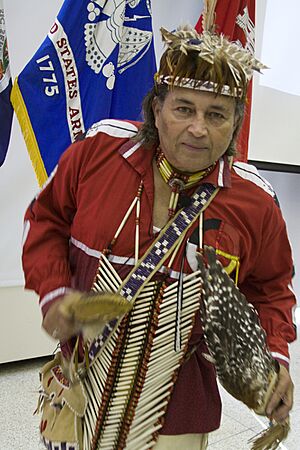Nottoway people facts for kids

Nottoway River in historic Nottoway territory
|
|
| Regions with significant populations | |
|---|---|
| Virginia | |
| Languages | |
| English, Nottoway (historical) | |
| Related ethnic groups | |
| Nansemond, Weyanock, Meherrin |
The Nottoway are a Native American tribe from Virginia. They are part of the Iroquoian family. The Nottoway people used to speak the Nottoway language. This language belongs to the Iroquoian language family.
Contents
What Does "Nottoway" Mean?
The name Nottoway might come from the word Nadawa. This word means "poisonous snake" in the Algonquian language. Some experts think it refers to a type of snake called the Massasauga. This snake lives near the Great Lakes.
Another idea is that Nottoway means "traders." This makes sense because the Nottoway often traded with other tribes. They exchanged shell beads for animal skins.
Other Algonquian-speaking tribes called the Nottoway, Meherrin, and Tuscarora people by the name Mangoak. English settlers also used this name in their records. The Dutch used a similar name, Mingwe, for other Iroquoian groups.
The Nottoway people call themselves Cheroenhaka. The meaning of Cheroenhaka is not fully clear. Some think it might mean "people at the fork of the stream." Others believe it relates to the word for "tobacco." Tobacco was important in their ceremonies.
The Nottoway Language
The Nottoway language is an Iroquoian language. Sadly, it died out before the 1900s. When Europeans first met the Nottoway in 1650, only a few hundred people spoke it.
Some colonists learned the language. They became official interpreters for the Colony of Virginia. These interpreters also helped the nearby Meherrin and Nansemond tribes. By 1735, the Nottoway mostly spoke English. So, the interpreters were no longer needed.
Around 1820, only three elderly Nottoway people still spoke the language. One of them was Chief Edith Turner. A man named John Wood collected over 250 Nottoway words from her. He sent them to Thomas Jefferson. Jefferson and another scholar, Peter Stephen Du Ponceau, confirmed it was an Iroquoian language. More words were collected later, bringing the total to about 275.
In the early 1900s, experts studied the Nottoway language. They found it was very similar to the Tuscarora language. Tuscarora is also an Iroquoian language.
Nottoway History
Early Life and European Contact
The Nottoway, like their neighbors the Meherrin and Tuscarora, lived in the Piedmont region of Virginia. This area is just west of the Fall Line.
In 1650, an English explorer named Edward Bland met the Nottoway. He was likely the first European to do so. He wrote about visiting two of their towns. These towns were in what is now Sussex County. At that time, there were about 400 to 500 Nottoway people.
Challenges and Changes
In 1680, a Nottoway leader signed the Treaty of Middle Plantation. This made the tribe a partner with the Virginia colony. However, English settlers started moving onto Nottoway lands.
The Nottoway had to move several times because of other tribes and settlers. They also faced terrible epidemics. Diseases like measles and smallpox came with the Europeans. The Nottoway had no natural protection against these illnesses. Many people died. Tribal wars also reduced their numbers.
In the early 1700s, some members of the Nansemond and Weyanock tribes joined the Nottoway. By 1705, there were about 400 Nottoway people left.
Treaties and Land Sales
In 1711, two young Nottoway men went to the College of William and Mary. After the Tuscarora War (1711–1715), some Tuscarora people moved north. They became part of the Haudenosaunee Confederacy. Some Nottoway people went with them.
The Nottoway who stayed in Virginia signed a treaty with the British in 1713. This treaty gave them two small areas of land. They sold one of these areas in 1734. They sold more land in 1744, 1748, and 1756.
By 1772, only 35 Nottoway people lived on their land. They even leased out half of it. By 1794, the tribe had only 7 men and 10 women and children.
The 1800s and Land Allotment
In the early 1800s, the Nottoway faced land disputes. The tribe did not have a formal government at this time. European-American trustees helped manage tribal issues. Nottoway members also married people of European-American and African-American backgrounds.
By 1808, only 17 Nottoway people remained. This included Billy Woodson and Chief Edith Turner. They owned 3,900 acres of land. Edith Turner ran a successful farm. She also helped four Nottoway orphans return to the tribe.
In 1818, the Nottoway asked the Virginia General Assembly to sell almost half of their land. They said there were only 26 Nottoway people left. Later, some Nottoway asked to end the reservation system. They wanted their land to be divided among individuals. Virginia passed a law in 1824 that allowed this.
Edith Turner and Billy Woodson applied for their own land shares in 1830. When Turner died in 1838, her land went to Edwin Turner. His children owned the last of the Nottoway reservation land. The last tribal land was divided in 1878.
Nottoway Culture
The Nottoway people grew important crops. These included the three sisters: maize (corn), squash, and beans. Women usually grew and prepared the crops. They also saved seeds for future planting. Men hunted animals and fished in the rivers.
The Nottoway lived in large homes called longhouses. Many families lived together in one longhouse. Their communities were protected by strong fences called palisades.
In the early 1700s, Nottoway girls wore necklaces made of wampum. Wampum are beads made from shells.
Modern Recognition
Today, two Nottoway groups are recognized by the state of Virginia. These are the Nottoway Indian Tribe of Virginia and the Cheroenhaka (Nottoway) Indian Tribe. They were recognized in February 2010. However, neither tribe is recognized by the United States federal government.
Images for kids




